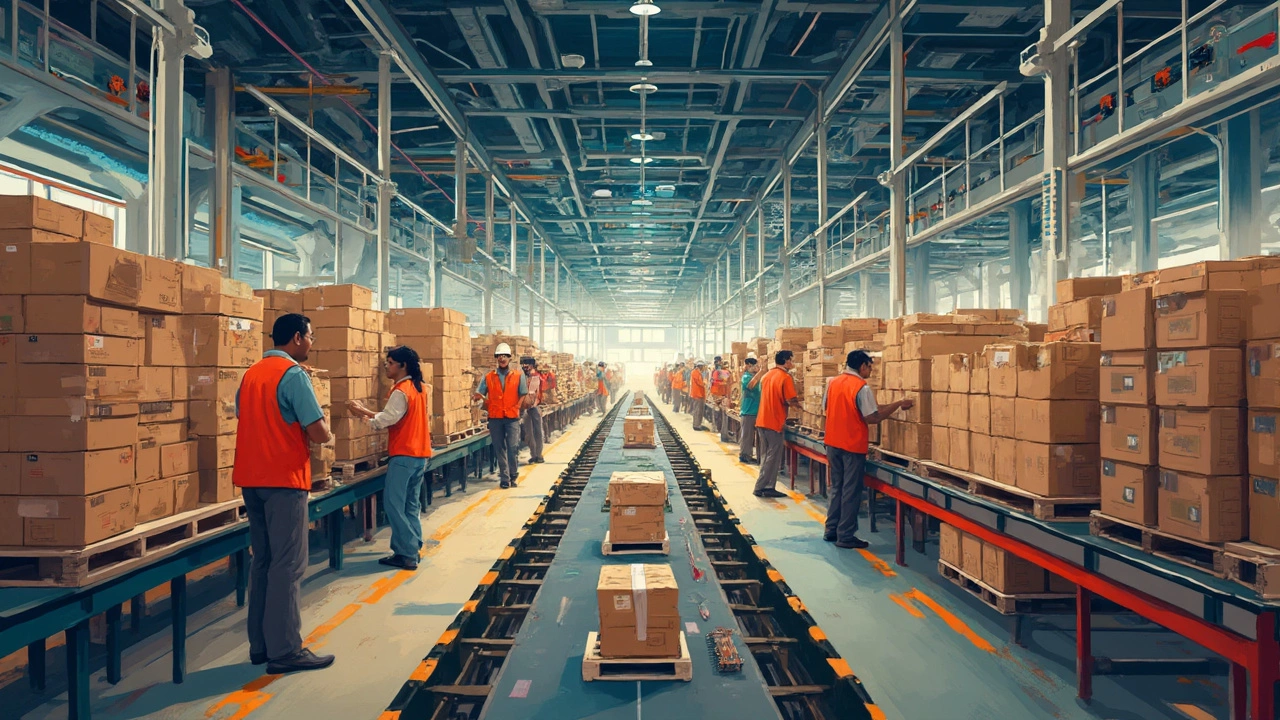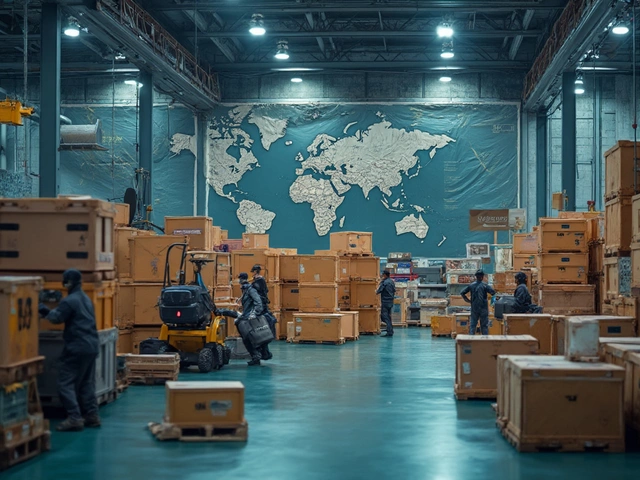Amazon's logistics world might seem like a maze to many, filled with giant warehouses and bustling delivery trucks. Ever wondered whether these vast warehouses are all Amazon's own? It's a bit of yes and no. While Amazon does own a fair chunk of its distribution centers, it's not just about ownership—leasing plays a big role too.
Imagine trying to keep up with delivering millions of packages every day. Owning some strategic locations gives Amazon control, but leasing allows them flexibility and speed to adjust to changes. It’s a delicate balance between having solid footholds and being nimble.
This setup affects how quickly they can move from one delivery promise to the next. It makes you appreciate that Prime delivery a bit more, doesn’t it? The strategy extends beyond basic logistics to include a complex web of third-party partners and software solutions, enhancing efficiency.
- Amazon's Warehouse Strategy
- Ownership vs. Leasing
- Impact on Logistics Operations
- Amazon’s Use of Third-Party Partners
Amazon's Warehouse Strategy
When you think about Amazon's warehouses, you're picturing huge spaces packed with pretty much everything you could ever imagine—ready to be snatched up and shipped out fast. But how do they pull off such a massive operation? Let’s break down their strategy.
Dynamic Footprint
Amazon's approach to its warehouse footprint is all about adaptability. Sure, they own certain key locations, especially near major cities where fast delivery is crucial. But they also lease a bunch of places. This gives them the flexibility to expand or contract their space as needed.
By mixing ownership and leasing, Amazon can quickly respond to market demands. If a new neighborhood suddenly starts ordering yoga mats by the ton, they can set up a local distribution hub without investing in permanent infrastructure, thanks to leased spaces.
Technology-Driven Efficiency
Inside these sprawling centers, it's not just about stacking boxes. Amazon uses advanced robotics and software systems to move things around more efficiently. The company is a pioneer in leveraging logistics software to optimize every step, from inventory placement to picking routes.
You might be surprised to learn that Amazon acquired Kiva Systems back in 2012, integrating their robots to streamline warehouse processes. This has cut down on labor costs and sped up delivery times, something that’s crucial for their Prime service.
Strategic Location Choices
Choosing warehouse locations isn't random. They're positioned strategically to cover major metropolitan areas, so your Prime order doesn’t take a detour to Siberia when you live in London. The closer they are to urban centers, the faster and cheaper the deliveries.
| Amazon Warehouse Stats |
|---|
| Over 185 fulfillment centers worldwide |
| More than 2.5 billion packages shipped annually |
This kind of setup not only keeps the shipping bills down but also ensures they meet those speedy delivery promises. After all, who wants to wait a week for their next must-read novel or cool gadget?
In conclusion, Amazon's warehouse strategy is a clever mix of ownership, leasing, and tech-driven efficiency, all carefully planned to get that package to your doorstep faster than you can say "click."
Ownership vs. Leasing
When it comes to Amazon's massive logistics network, the question of owning versus leasing their warehouses is a big deal. Ever wondered how they decide? It's all about strategy and adapting to their needs.
Why Amazon Owns Some Warehouses
Amazon does own plenty of its warehouses, especially the ones critical for fast delivery and those situated in prime locations. Owning means control. They can tweak operations without waiting for a landlord's approval and invest in high-tech innovations, making everything run smoother and faster.
The Benefits of Leasing
Leasing kicks in where flexibility is key. Market trends change fast, and sometimes renting is just smarter. Amazon can quickly enter new markets or expand in regions where purchasing property isn't feasible. Plus, leasing reduces the upfront capital outlay needed to scale operations rapidly.
A Balanced Approach
Amazon's mix of ownership and leasing helps it stay agile while maintaining control over critical hubs. This balance allows them to respond promptly to new business demands without being bogged down by the complexities of property ownership.
Just picture how this might look:
| Approach | Percentage of Warehouses |
|---|---|
| Owned | About 40% |
| Leased | About 60% |
It's a thriving logistics strategy. So, whether it's Prime delivery in a major city or reaching out to rural areas, Amazon pretty much has a plan for it. They keep a tight grip on crucial operations while leaving room to maneuver wherever and whenever they need to.

Impact on Logistics Operations
Amazon's mix of owned and leased warehouses plays a crucial role in its logistics operations. This strategy offers them both stability and flexibility, allowing them to expand or contract physical space based on demand. Now, why does this matter? Because a well-balanced approach directly affects how efficiently they can process and deliver products to their customers.
By owning key warehouses, Amazon secures essential locations that are pivotal for their distribution network. These owned spots often serve as hubs where major operations occur, providing a strong foundation for logistics. The upside? Reduced risk of disruptions, as they're not solely relying on another entity's terms and availability.
On the leasing side, the benefits are all about agility. Leased warehouses allow Amazon to scale operations quickly, responding to market trends or regional demand spikes. Imagine a leasing plan letting them ramp up space during the holiday rush and dial it back post-season.
Impact on Delivery Times
This ownership model impacts delivery times significantly. With careful positioning of both owned and leased warehouses, Amazon ensures inventory is closer to customers. Have you noticed how they manage to deliver even the smallest orders in lightning speed? That’s the logistics network working like a charm.
Optimization with Technology
Amazon doesn’t just rely on brick-and-mortar alone; their logistics operations are powered by technology. Warehouses are optimized with advanced logistics software and robotics, ensuring maximum efficiency. This tech integration means less human error and quicker processing times, which is crucial for meeting the high demand of their services like Prime.
In a nutshell, owning some warehouses while leasing others gives Amazon a level of operational flexibility that’s pretty hard to beat. It’s a strategy that helps weave an intricate yet effective distribution network, critical for maintaining their foothold as a retail giant.
Amazon’s Use of Third-Party Partners
When you think of Amazon, you might picture vast warehouses and a fleet of delivery vans, but there's more behind the curtain. Amazon heavily relies on third-party partners to keep its massive logistics machine humming along smoothly. These partners help Amazon provide the speedy deliveries you've come to expect and offer logistical flexibility.
The Role of 3PL Companies
Third-party logistics (3PL) companies play a crucial role in Amazon's logistics network. By partnering with these external logistics specialists, Amazon can tap into additional resources and expand rapidly without having to build or buy every warehouse themselves. This is like having a backup team when things get particularly busy.
What's more, these partnerships allow Amazon to test new markets or expand their reach more cost-effectively. Instead of committing to owning a warehouse, they can lease space through a 3PL and see how it pans out. It’s a smart way to try before you buy.
Amazon's Partner Network
Amazon also uses a network of delivery service partners (DSPs) to handle the last-mile delivery tasks. These are independent companies under contract with Amazon, delivering parcels to your door. This strategy not only expands Amazon’s reach but also provides opportunities for small businesses.
Recent Stats on Partner Contributions
An interesting fact is that more than half of all items sold on Amazon are from third-party sellers utilizing Amazon's logistics. Here’s a small snapshot to chew on:
| Metric | Percentage |
|---|---|
| Items from Third-Party Sellers | 55% |
| Third-Party Packages Delivered by Amazon | 63% |
This shows how important these partners are in supporting Amazon’s logistical prowess and expanding their product offerings.
So, while it might look like Amazon is doing it all on their own, these third-party partners are the unsung heroes making sure you get your orders on time. It's a massive web of interconnected efforts that keeps the entire system rolling.





